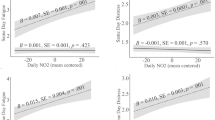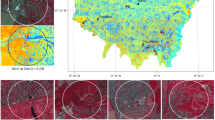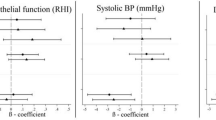Abstract
Little is known about environmental determinants of sleep. We investigated the association between black carbon (BC), a marker of traffic-related air pollution, and sleep measures among participants of the Boston Area Community Health Survey. We also sought to assess the impact of sociodemographic factors, health conditions, and season on associations. Residential 24-h BC was estimated from a validated land-use regression model for 3821 participants and averaged over 1–6 months and 1 year. Sleep measures included questionnaire-assessed sleep duration, sleep latency, and sleep apnea. Linear and logistic regression models controlling for confounders estimated the association between sleep measures and BC. Effect modification was tested with interaction terms. Main effects were not observed between BC and sleep measures. However, in stratified models, males experienced 0.23 h less sleep (95% CI: −0.42, −0.03) and those with low SES 0.25 h less sleep (95% CI: −0.48, −0.01) per IQR increase in annual BC (0.21 μg/m3). In blacks, sleep duration increased with annual BC (β=0.34 per IQR; 95% CI: 0.12, 0.57). Similar findings were observed for short sleep (≤5 h). BC was not associated with sleep apnea or sleep latency, however, long-term exposure may be associated with shorter sleep duration, particularly in men and those with low SES, and longer sleep duration in blacks.
This is a preview of subscription content, access via your institution
Access options
Subscribe to this journal
Receive 6 print issues and online access
$259.00 per year
only $43.17 per issue
Buy this article
- Purchase on Springer Link
- Instant access to full article PDF
Prices may be subject to local taxes which are calculated during checkout

Similar content being viewed by others
References
Colten H, ALtevogt B eds. Institute of Medicine Report: Sleep Disorders and Sleep Deprivation, An Unmet Public Health Problem. The National Academies Press: Washington, DC. 2006.
Cappuccio FP, Cooper D, D'Elia L, Strazzullo P, Miller MA . Sleep duration predicts cardiovascular outcomes: a systematic review and meta-analysis of prospective studies. European Heart J 2011; 32: 1484–1492.
Hoevenaar-Blom MP, Spijkerman AM, Kromhout D, van den Berg JF, Verschuren WM . Sleep duration and sleep quality in relation to 12-year cardiovascular disease incidence: the MORGEN study. Sleep 2011; 34: 1487–1492.
Sabanayagam C, Shankar A . Sleep duration and cardiovascular disease: results from the National Health Interview Survey. Sleep 2010; 33: 1037–1042.
Ferrie JE, Shipley MJ, Cappuccio FP, Brunner E, Miller MA, Kumari M et al. A prospective study of change in sleep duration: associations with mortality in the Whitehall II cohort. Sleep 2007; 30: 1659–1666.
Budhiraja R, Budhiraja P, Quan SF . Sleep-disordered breathing and cardiovascular disorders. Respir Care 2010; 55: 1322–1332.
Shahar E, Whitney CW, Redline S, Lee ET, Newman AB, Nieto FJ et al. Sleep-disordered breathing and cardiovascular disease: cross-sectional results of the Sleep Heart Health Study. Am J Respir Crit Care Med 2001; 163: 19–25.
Hale L, Do DP . Racial differences in self-reports of sleep duration in a population-based study. Sleep 2007; 30: 1096–1103.
Adenekan B, Pandey A, McKenzie S, Zizi F, Casimir GJ, Jean-Louis G . Sleep in America: role of racial/ethnic differences. Sleep Med Rev 2012; 17: 255–262.
Krueger PM, Friedman EM . Sleep duration in the United States: a cross-sectional population-based study. Am J Epidemiol 2009; 169: 1052–1063.
Grandner MA, Patel NP, Gehrman PR, Xie D, Sha D, Weaver T et al. Who gets the best sleep? Ethnic and socioeconomic factors related to sleep complaints. Sleep Med 2010; 11: 470–478.
Miedema HM, Vos H . Associations between self-reported sleep disturbance and environmental noise based on reanalyses of pooled data from 24 studies. Behav Sleep Med 2007; 5: 1–20.
Hale L, Hill TD, Friedman E, Javier Nieto F, Galvao LW, Engelman CD et al. Perceived neighborhood quality, sleep quality, and health status: evidence from the survey of the health of Wisconsin. Soc Sci Med 2012; 79: 16–22.
Cohrs S, Rodenbeck A, Riemann D, Szagun B, Jaehne A, Brinkmeyer J et al. Impaired sleep quality and sleep duration in smokers-results from the German Multicenter Study on Nicotine Dependence. Addict biology 2012; 19: 486–496.
Roehrs T, Roth T . Sleep, sleepiness, sleep disorders and alcohol use and abuse. Sleep Med Rev. 2001; 5: 287–297.
Brook RD, Rajagopalan S, Pope CA, 3rd, Brook JR, Bhatnagar A, Diez-Roux AV et al. Particulate matter air pollution and cardiovascular disease: An update to the scientific statement from the American Heart Association. Circulation 2010; 121: 2331–2378.
Health effects of outdoor air pollution. Committee of the Environmental and Occupational Health Assembly of the American Thoracic Society. American journal of respiratory and critical care medicine 1996; 153: 3–50.
Dockery DW, Pope CA, 3rd . Acute respiratory effects of particulate air pollution. Annual review of public health 1994; 15: 107–132.
Nakata A, Takahashi M, Haratani T, Ikeda T, Hojou M, Fujioka Y et al. Association of active and passive smoking with sleep disturbances and short sleep duration among japanese working population. Int J Behav Med 2008; 15: 81–91.
Sabanayagam C, Shankar A . The association between active smoking, smokeless tobacco, second-hand smoke exposure and insufficient sleep. Sleep Med 2011; 12: 7–11.
Davila EP, Lee DJ, Fleming LE, LeBlanc WG, Arheart K, Dietz N et al. Sleep disorders and secondhand smoke exposure in the US population. Nicotine Tob Res 2010; 12: 294–299.
Franklin KA, Gislason T, Omenaas E, Jogi R, Jensen EJ, Lindberg E et al. The influence of active and passive smoking on habitual snoring. Am J Respir Crit Care Med 2004; 170: 799–803.
Yolton K, Xu Y, Khoury J, Succop P, Lanphear B, Beebe DW et al. Associations between secondhand smoke exposure and sleep patterns in children. Pediatrics 2010; 125: e261–e268.
Zanobetti A, Redline S, Schwartz J, Rosen D, Patel S, O'Connor GT et al. Associations of PM10 with sleep and sleep-disordered breathing in adults from seven U.S. urban areas. Am J Respir Crit Care Med 2010; 182: 819–825.
Abou-Khadra MK . Association between PM(10) exposure and sleep of Egyptian school children. Sleep Breath 2012; 17: 653–657.
Wilker EH, Baccarelli A, Suh H, Vokonas P, Wright RO, Schwartz J . Black carbon exposures, blood pressure, and interactions with single nucleotide polymorphisms in microRNA processing genes. Environ Health Perspect 2010; 118: 943–948.
Gryparis A, Coull B, Schwartz J, Suh H . Semiparametric latent variable regression models for spatiotemporal modelling of mobile source particles in the greater Boston area. J R Stat Soc Ser C Appl Stat 2007; 56: 183–209.
McKinlay JB, Link CL . Measuring the urologic iceberg: design and implementation of the Boston Area Community Health (BACH) Survey. Eur Urol 2007; 52: 389–396.
Franco Suglia S, Gryparis A, Schwartz J, Wright RJ . Association between traffic-related black carbon exposure and lung function among urban women. Environ Health Perspect 2008; 116: 1333–1337.
Fang SC, Mehta AJ, Alexeeff SE, Gryparis A, Coull B, Vokonas P et al. Residential black carbon exposure and circulating markers of systemic inflammation in elderly males: the normative aging study. Environ Health Perspect 2012; 120: 674–680.
Netzer NC, Stoohs RA, Netzer CM, Clark K, Strohl KP . Using the Berlin Questionnaire to identify patients at risk for the sleep apnea syndrome. Ann Int Med 1999; 131: 485–491.
Pope CA, 3rd, Dockery DW, Spengler JD, Raizenne ME . Respiratory health and PM10 pollution. A daily time series analysis. Am Rev Respir Dis 1991; 144: 668–674.
United States Public Health Service. Office of the Surgeon General. The health consequences of involuntary exposure to tobacco smoke: a report of the Surgeon General. US Department of Health and Human Services, Public Health Service, Office of the Surgeon General: Rockville, MD, USA. 2006 xvii 709 pp.
Oberdorster G, Sharp Z, Atudorei V, Elder A, Gelein R, Kreyling W et al. Translocation of inhaled ultrafine particles to the brain. Inhal Toxicol 2004; 16: 437–445.
Cruts B, van Etten L, Tornqvist H, Blomberg A, Sandstrom T, Mills NL et al. Exposure to diesel exhaust induces changes in EEG in human volunteers. Part Fibre Toxicol 2008; 5: 4.
Power MC, Weisskopf MG, Alexeeff SE, Coull BA, Spiro A, 3rd, Schwartz J . Traffic-related air pollution and cognitive function in a cohort of older men. Environ Health Perspect 2011; 119: 682–687.
Gerlofs-Nijland ME, van Berlo D, Cassee FR, Schins RP, Wang K, Campbell A . Effect of prolonged exposure to diesel engine exhaust on proinflammatory markers in different regions of the rat brain. Part Fibre Toxicol 2010; 7: 12.
Levesque S, Surace MJ, McDonald J, Block ML . Air pollution & the brain: subchronic diesel exhaust exposure causes neuroinflammation and elevates early markers of neurodegenerative disease. J Neuroinflammation 2011; 8: 105.
Campbell A, Oldham M, Becaria A, Bondy SC, Meacher D, Sioutas C et al. Particulate matter in polluted air may increase biomarkers of inflammation in mouse brain. Neurotoxicology 2005; 26: 133–140.
Bertini G, Colavito V, Tognoli C, Seke Etet PF, Bentivoglio M . The aging brain, neuroinflammatory signaling and sleep-wake regulation. Ital J Anat Embryol 2010; 115: 31–38.
Pan W, Wu X, He Y, Hsuchou H, Huang EY, Mishra PK et al. Brain interleukin-15 in neuroinflammation and behavior. Neurosci Biobehav Rev 2013; 37: 184–192.
Forastiere F, Stafoggia M, Tasco C, Picciotto S, Agabiti N, Cesaroni G et al. Socioeconomic status, particulate air pollution, and daily mortality: differential exposure or differential susceptibility. Am J Ind Med 2007; 50: 208–216.
Jerrett M, Burnett RT, Brook J, Kanaroglou P, Giovis C, Finkelstein N et al. Do socioeconomic characteristics modify the short term association between air pollution and mortality? Evidence from a zonal time series in Hamilton, Canada. J Epidemiol Community Health 2004; 58: 31–40.
Romieu I, Gouveia N, Cifuentes LA, de Leon AP, Junger W, Vera J et al. Multicity study of air pollution and mortality in Latin America (the ESCALA study). Res Rep Health Eff Inst 2012; 171: 5–86.
O'Neill MS, Jerrett M, Kawachi I, Levy JI, Cohen AJ, Gouveia N et al. Health, wealth, and air pollution: advancing theory and methods. Environ Health Perspect 2003; 111: 1861–1870.
Colais P, Faustini A, Stafoggia M, Berti G, Bisanti L, Cadum E et al. Particulate air pollution and hospital admissions for cardiac diseases in potentially sensitive subgroups. Epidemiology 2012; 23: 473–481.
Maynard D, Coull BA, Gryparis A, Schwartz J . Mortality risk associated with short-term exposure to traffic particles and sulfates. Environ Health Perspect 2007; 115: 751–755.
Ram S, Seirawan H, Kumar SK, Clark GT . Prevalence and impact of sleep disorders and sleep habits in the United States. Sleep Breath 2010; 14: 63–70.
Acknowledgements
We wish to acknowledge Rebecca Piccolo for geocoding the data and Steven Melley and Alexandros Gryparis for the BC predictions. Funding for this research was provided by a grant from the National Institute on Minority Health and Health Disparities R21MD006769.
Author information
Authors and Affiliations
Corresponding author
Ethics declarations
Competing interests
The authors declare no conflict of interest.
Rights and permissions
About this article
Cite this article
Fang, S., Schwartz, J., Yang, M. et al. Traffic-related air pollution and sleep in the Boston Area Community Health Survey. J Expo Sci Environ Epidemiol 25, 451–456 (2015). https://doi.org/10.1038/jes.2014.47
Received:
Revised:
Accepted:
Published:
Issue Date:
DOI: https://doi.org/10.1038/jes.2014.47
Keywords
This article is cited by
-
The long-term and short-term effects of ambient air pollutants on sleep characteristics in the Chinese population: big data analysis from real world by sleep records of consumer wearable devices
BMC Medicine (2023)
-
Exposure to polycyclic aromatic hydrocarbons increases the risk of poor sleep pattern in US adults: results from the NHANES (2005–2010)
Environmental Science and Pollution Research (2023)
-
Solid fuels use for cooking and sleep health in adults aged 45 years and older in China
Scientific Reports (2021)



